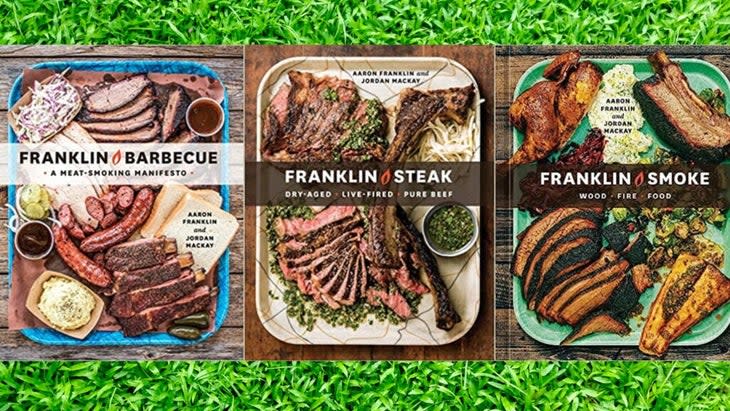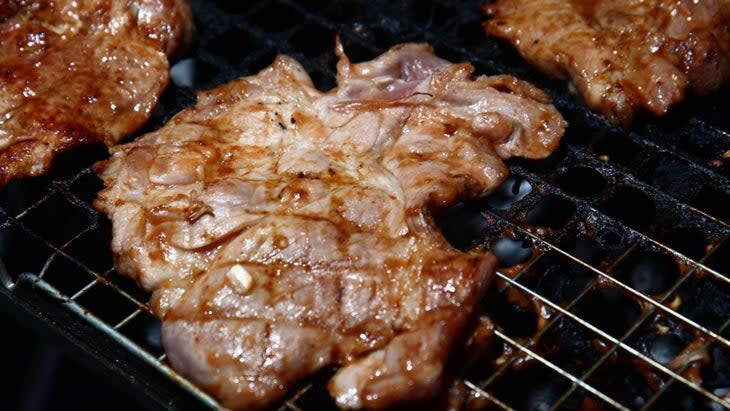All Your Questions About Barbecue, Answered
This article originally appeared on Outside
It's not hyperbole to say that Franklin Barbecue in Austin, Texas, is the biggest name in the business. The man behind the brand--Aaron Franklin--has become a celebrity in his own right after doing the unthinkable: giving away his recipe for perfect brisket in his first book Franklin Barbecue: A Meat-Smoking Manifesto ($29.99, Ten Speed Press, 2015). In doing so, he fundamentally changed the reach of barbecue in this country.
Texas Monthly's barbecue editor Daniel Vaughn says: "When the most famous brisket cook the world has ever seen tells you exactly how to replicate his cash cow, enterprising pitmasters are going to do exactly that," he wrote in 2021. "Much of our current glut of superlative smoked brisket comes from barbecue joints that opened in the post-Franklin barbecue world...a whole lot of Texas brisket tastes like we're eating a cover song. Granted, it's a cover of the greatest barbecue tune ever written."

His second book, Franklin Steak: Dry-Aged. Live-Fired. Pure Beef, details the glory of steak. And in May, his third book was released: Franklin Smoke: Wood. Fire. Food, and no doubt, it too will become a bestseller. But where Aaron Franklin has the know-how, it's the trilogy's co-author Jordan Mackay, a wine writer since turned barbecue fanatic, who brings Franklin's wisdom and technique to the page. We sat down with Mackay to talk about the book, the difference between barbecuing and grilling, the importance of smoke, and a favorite recipe.
Outside: Tell us about this new book, the third in the Franklin trilogy.
Jordan Mackay: This one is more of a cookbook. The first one is about what Aaron does at Franklin Barbecue. It's very classically based around the staples of central Texas barbecue. The second book is a super deep dive on steak--ranching, quality of beef, dry aging, cutting, preparing, grilling. I don't think that's been done before and I'm really proud of it. This third one is an intersection of grilling and smoking. The aim is to get the most use of the fire from beginning to end, and get some of the smoke qualities and things we love about barbecue with the fast action of grilling.
Outside: Many people use the terms "barbecuing" and "grilling" interchangeably, but they're not the same. Can you help define each?
Jordan Mackay: Barbecuing is very different than putting pork chops on a deck grill. Grilling is fast cooking and it requires certain ingredients and cuts of meat that cook quickly. Flavors are largely born of--in the case of a gas grill--the vaporization of juices hitting a hot surface and emanating back up to coat the food. Barbecuing is slow and what we really love is cooking with wood and [the flavor of] wood smoke. When you cook over wood coals, it's different from gas or charcoal in that you get the best out of grilling and you get the most out of the smoke action.
Outside: There's good smoke and bad smoke, yes?
Jordan Mackay: It's so crucial to get good smoke versus bad smoke. [For the record, the best, most flavorful smoke is faintly blue and a result of your fire being 650degF-700degF.] Some chefs really get into 'I can smoke this and that,' and they'll put coals in a hotel pan and cover it. Often that's not good smoke, it's acrid. As much as Aaron and I represent the existence of smoke-we also caution against it. We're not into doing everything with smoke. We treat it like a seasoning.
Outside: This book is first and foremost about fire--building it, tending to it, eking out every bit of its heat and magic. According to Aaron, there are six stages of fire--ignition, white smoke, flame, coals, embers, and ash--and each can and should be used for cooking.
Jordan Mackay: If you're going to create a fire, it takes a lot of effort and resources. It's a lifestyle choice for that day or night and you don't want to waste it. Cooking over fire makes everything better. It's like when you go camping, my mom used to say that when we went backpacking-- even when we were adding water to freeze-dried meals that we got at REI--that eating and cooking outside is better.
Outside: Of the many recipes in the book, one that gave me a double take was Jordan's Perfect Green Salad. There are just five ingredients (of which one is "restraint") but it's two pages long, three with the photo. Tell me about this.
Jordan Mackay: First, [the salad] is really the perfect antidote to barbecue and grilled meats. But as much as this is a recipe book, we're not into recipes, we're into technique. We're geeks about technique. I can pretty much take any recipe, including a salad, and spin it out into 2 to 3 pages. When you learn the underpinnings of why something works, then you can add your own twist. As much as there are more recipes [in this book], they're meant to be inspirations and templates to cooking on your own.
Outside: OK, recipe or not, name one of your favorites in the book.
Jordan Mackay: The pork shoulder steaks. They're a commitment but worth it.
Pork Shoulder Steaks Recipe Here

For exclusive access to all of our fitness, gear, adventure, and travel stories, plus discounts on trips, events, and gear, sign up for Outside+ today.

